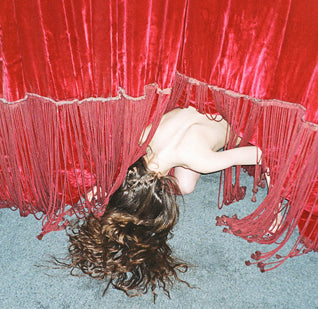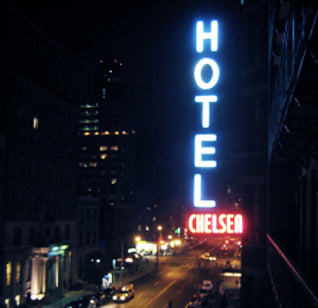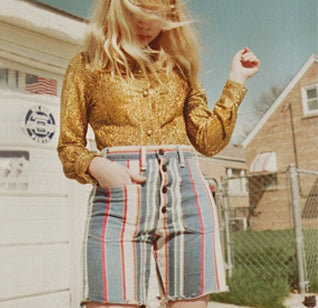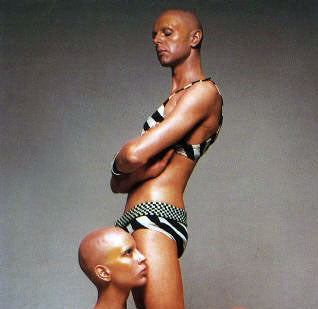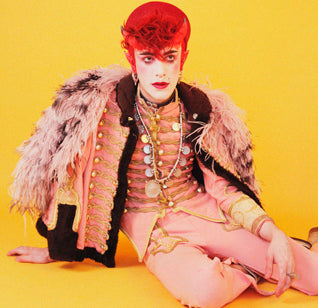PLANET OF THE APES
Monkeys are the human metaphor in Anja Priska’s cartoon world
by Maria Raposo
“It feels like the whole world is full of monkeys,” artist Anja Priska tells me in her soft German accent. Looking around her East London studio, I can see what she means – we’re surrounded. Monkey masks hang in the kitchen, monkey paintings lean against the wall and sculptures of monkeys are hunched on the table.
Sharing her chair with a stuffed toy ape, Anja tells me she’s had monkeys on her mind since 2009 and she plans to never paint anything else. “The monkeys are actors, they represent us. They’re human metaphors, and a representation of me. But art is always about the artist.”

Anja Priska by Roman Skyva, 2013
The monkeys in Anja’s paintings inhabit surreal worlds set against faultless panes of smooth, soft color. These abstract backgrounds are demanding in terms of technique: “If I make a mistake I have to start from scratch so I do loads of tests, planning them to the centimeter”. Her works have a painterly cartoon aesthetic - “Humor is so important” she says. “It’s one of the most appealing ways to interact with people”.
Always concerned with the accessibility of her work, Anja sees cartoons as a “well-known language”, grabbing the attention of her audience with glimmers of childhood nostalgia. However her style is not just about snaring potential buyers – she loves the “the bold shapes, black outlines and flat colors” found in children’s books and television programs.
“The monkeys are actors, they represent us. They’re human metaphors, and a representation of me. But art is always about the artist.”
Anja never watched cartoons as child: “I only watched Bambi this winter. I was told in school that cartoons make you stupid.” Even when she went to friends’ houses, she would only pretend to read them – terrified they would somehow dent her intelligence. “Oh my god, it’s going to make me dumb!” she jokes, mimicking her younger self.
Bambi features in many of Anja’s most recent works – but this is not the innocent deer we met through Walt Disney. It’s as if this Bambi has escaped from a perverse nightmare – complete with bulging breasts and a monkey peering out from his left eye-socket, it’s unsettling to say the least. I ask her why she chooses to sexualize classic children’s characters, but she laughs, “Oh my god, am I doing that?! It’s not erotic or sexual, more comical” she says, correcting me.
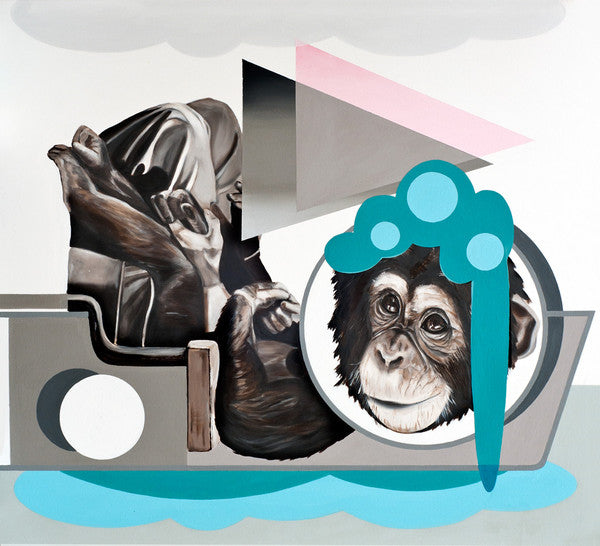
Anja Priska, 'Loveboat', 2013
She explains how, in the past, her work has been “too honest, too dark and too dramatic” but these days the darker elements are carefully masked. Anguish is still very present in her work, usually taking the form of puddles or raindrops. However she has the restraint to dilute her emotions with accessible motifs, a sophisticated move for such a young artist. As we talk about the painting ‘Stargazer’, this sadness becomes more obvious and Anja struggles to find her usual, upbeat tone of voice. “It’s about unbalanced relationships. The monkey is relaxed but this other part is lying in the rain, trying to support the monkey”.
With bright red hair and tattoos creeping down her slender arms, she’s very honest. With little encouragement she explains the personal meaning of each work. ‘Blind Trust’ is about the “trust, loss and despair” of relationships, she says. The monkey in the painting is blinded by a pink, ice cream-like substance that melts over its eyes and slides down its back. Anja calls this the “sticky, sweetness of love”. It’s the feeling you get when you’re so captivated by another person and you can’t see anything but them.
We’ve all been there, and that’s the point. She calls her art “democratic”, picking issues that are relevant to the widest audience possible – “so that people can find themselves in the work”.

Anja Priska, 'Hermina, Snow White and Black as Night', 2013
In ‘Remote Control’, we see a monkey lounging on a cloud. It gestures in our direction, as if it’s trying to change the channel but the remote control is missing. Mickey Mouse hands emerge from a smooth and minimal background, and the cloud floats without direction. It’s about control. “You could project this onto the art world” Anja says. ”I can paint for 24 hours a day but its luck that gets you noticed.”
Moving from Munich to The UK in 2005, Anja describes her first eight months in London as a “nightmare”, recalling a lonely existence where all she did was art. It was only when she moved to Hackney Wick, five years ago, that she started to make friends. But even now, she tells me, “I’m not hanging out much, I just stay here and do my work”.
The 38-year-old has made a lot of compromises to get to this point and in an exhausted economy, this is unavoidable. She admits that there is “no line between privacy and work” because her home is her studio – it’s where she sleeps. But this complete dedication has paid off and unlike many artists, Anja’s distinct style is vibrant, recognizable and constant; the latter being incredibly important for collectors.
Despite the comic content of her paintings, the way Anja deals with emotion reveals a stylistic maturity. She’s switched on; she knows that if her work is completely introspective, it won’t sell. She’s capable of making her anxieties accessible to a broad audience and her paintings remain light and enjoyable even when heavy with underlying anguish.
See Anja's work on Kids of Dada.












